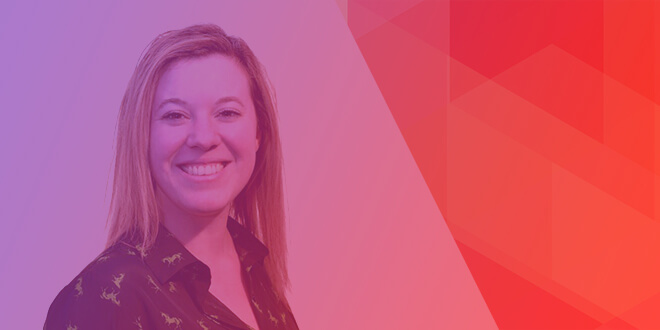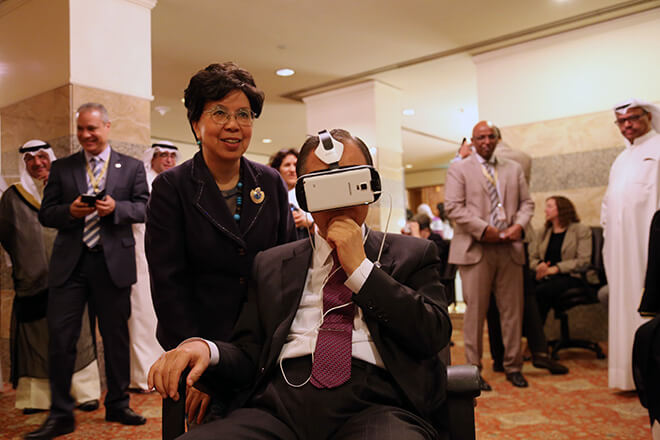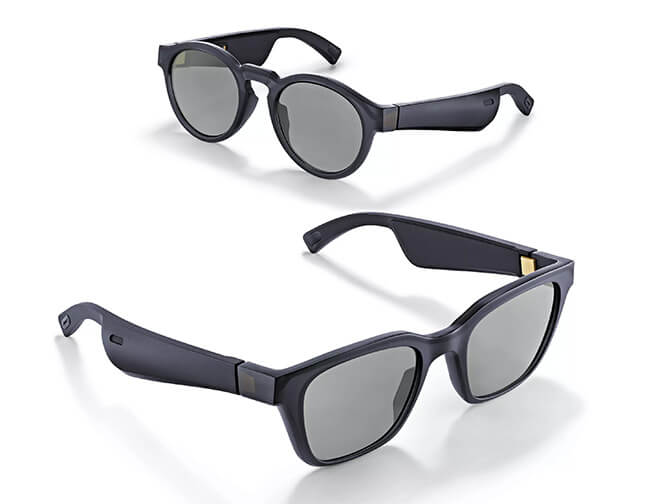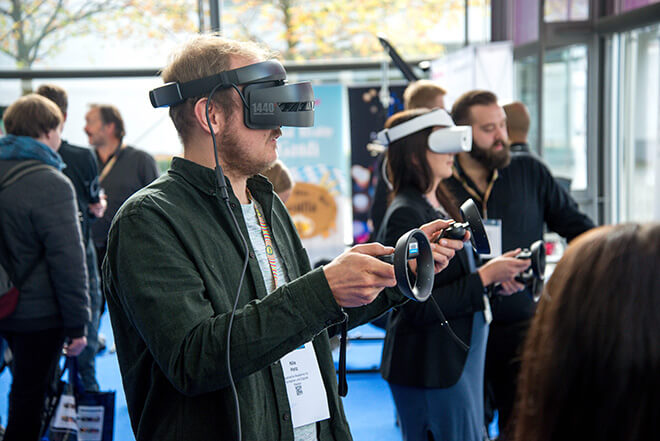
Kristin Gutekunst on VR for good
It didn’t take me long when I started doing research about fundraising via virtual reality to bump into UNVR, the (now defunct) groundbreaking advocacy-through-VR program at the United Nations. I was impressed by the quality of their content and by how early they were using VR for good. I met with Kristin Gutekunst, Co-Founder & CEO of Overview Collective, and a member of the original team at UNVR.
Can you tell me more about UNVR and what you did there?
Gabo Arora & Chris Milk created Clouds over Sidra in January 2015 (way ahead of when there were actually consumer headsets) with the added value of us being in the United Nations and having access to some of the world’s decision makers as well as a huge network of partners who were also looking to communicate the same issues.
A lot of the content that we made was really brand agnostic in terms of the different UN agencies. We tried to have a broad approach so that it could be really tailored for different advocacy messages. My role as executive producer was essentially building those partnerships and designing the launch and the brand building of UNVR and the different films, as well as running a lot of the exhibits.
Then I really started experimenting with students on how to build curriculum around this and use VR as a guided discussion tool. How can we send people on trips to places they might not even be interested in seeing and get them to understand the humanity in the numbers? We benefited from this niche of being in-between diplomacy, entertainment, and the new emerging tech to hit many different media markets. We were really successful in the beginning with having a lot of attention drawn to it.
How did you work with Gabo on these projects?
As Gabo was really interested and in charge of creating content, I was really interested in fostering the ecosystem around it, which meant creating some of the high level partnerships with headset companies—who helped us with donations, or actually just sending brand ambassadors to host exhibits around the world—or with companies and creators who wanted to help us curate and exhibit content.
We started to get into the space of doing exhibits all over the place: pop ups or one week long exhibits and then helping our different U.N. teammates with how they build their strategies around it. One of the difficulties I think a lot of the U.N. agencies faced was that they often didn’t have the full perspective of how to use the tech effectively considering the cost. A lot of times it was created for a one off event or for one particular moment without a broader campaign focus or the tie-in to fundraising or the different asks to be able to track how effective it was.
Some of the strategic planning approaches and the different ways that we tried to use VR for impact have become systematic in terms of how I continue to work with different entities, especially in VR for Good—ensuring that these boxes are ticked.
What happened to the program?
The Campaign was going through a difficult time because it moved from the Millennium Development era to the Sustainable Development era which meant that the mandate and the fundraising ended and all had to restart.
It was hard to continue going out the partners and creating all these new initiatives and promises without having the security of a longer term plan in mind. Some of that was management issues at the U.N. There was a huge restructure that was happening at the same time and they were changing a lot of how the campaign was structured. The VR program got caught in the middle and wasn’t able to be sustained anymore.
I moved over to the World Food Program and I helped them launch the first augmented reality and then designed a rollout strategy to incorporate experiential marketing exhibits into their outreach, fundraising, partnership building, et cetera. So I did that for the last year and now I have my own company.

UN Secretary-General Ban Ki-moon & Executive Director, WHO Margaret Chan –
Photo credit David Gough
Was fundraising part of your overall strategy from the beginning or did you start with advocacy and then crossed the line to fundraising?
We never really had the strongest plan with any of these things, we were only focusing specifically on fundraising for one or two of these projects, but it doesn’t mean we didn’t do it for fundraising.
[Clouds over Sidra] was first shown at the World Economic Forum and then the second showing was at the Third International Humanitarian Pledging Conference for Syria in Kuwait with OCHA.
They showed it to the highest level people which included the Secretary-General, the Director of the WHO, some of the VVIP that were there before the actual conference started, in a private dinner. The next day the Secretary-General changed his speech so that it included stories about the girl that he saw [in Clouds over Sidra] and they ended up raising more money than they had predicted.
With VR it’s very difficult to make those strong inferences, to say “we changed opinion and they gave more” because commitments is one thing and actuals is another. But many people said that they thought that it had had a strong influence. So that was one of the first moments where we were like “oh my goodness!” And we had other kinds of really amazing little anecdotes, like a school visited the UN, they watched the film, they had just worked on a short essay about whether they thought the US should accept more Syrian refugees and then many of them actually requested that they could change their answer after watching the film. So little stories like that which are really amazing.
Anything you’d do differently?
One of the things that I really regret with the program is that we didn’t have as much focus on the evaluation side of things internally because we were just such a small team. UNICEF did an amazing study that really looks at how to use VR for face-to-face fundraising and they tested it in many different languages and markets and they saw increases of about 30 to 70 percent of face to face fundraising giving across many variables which included the locations they could access, whether people stopped to engage, how long they engaged, whether they signed up for a newsletter, if they signed up to be a donor, how much they gave, how long they stayed as a donor. All of these variables were positively affected. They never really released that data but they publicly talked about it in different events and different workshops and presentations.
And that was at a time when there were few VR headsets on the market. When you see how affordable consumer VR technology is becoming what are you most excited about?
There are different directions that it’s going in. One thing that I think is still a barrier is sifting through the content and having places where you know this content is going to be good. I still feel that a lot of people watch VR either because they’re 100% passionate and they do it all the time or because it’s experiential for them: location-based like going to a museum or going to an event.
I think it’s going to be a really amazing tool for schools to help young people learn about different situations and to visit places that have that kind of experience. I’m excited about how we’re going to continue to innovate about how we distribute this content.
Personally I think there’s always going to be another level of it which is going to be pushing the tech forward in terms of how we mix it with A.I., sound immersion, and movements in the six degrees of freedom. But it’s not going to have the same type of access for the general public which is where I want to see more of the adoption happening.

Bose Frames offer an immersive audio experience through spatialized sound
Would this happen faster with AR, then?
AR is accessible to everybody on their phone or tablet. People who have been using Snapchat for many years are using AR and they don’t even know it.
I think again, it’s still a distribution problem: Finding out about the different apps and wanting to use them—and have another app on your phone. But once it starts to be something that’s more streamlined into necessary elements of our lives, whether it’s audio or it’s visual and it’s helping us to navigate the world better, I think that’s when it’s really going to see the mass adoption we want. How can I find this more easily? How can I understand cost comparisons and see it in a visual way instead of just like looking at it in a supermarket? That’s what it’s going to be to the mass adoption level.
As a producer did you have any experience with more traditional medium before getting into the 360 space?
A lot of event production, a lot of exhibitions and photo narrative exhibitions, some multi-media but mostly advocacy focused: a lot of sites specific or moment in time specific things. We did a lot of online campaigns with collecting people’s opinions and highlighting them with young people, for example.
Do you witness a particular interest in VR and AR?
In just the last year of doing exhibits we have had many different offerings: VR, AR, just the traditional hydroponics (for example) that you can touch and feel, video drones and chat bots, stories that you can play with on an iPad but people still go and gravitate towards the VR because a lot of people still don’t have headsets at home. “Oh this is different. I want to see what’s going on here.”
Any tips on what works—and doesn’t?
The content has to be good or they’re not going to watch it and you have to have a different strategy for web VR than what you have on your headset. So you have to grab them in those first few minutes. If it’s for the general public and it’s in a busy space it has to be shorter and more engaging and not as overwhelming in terms of the facts and figures. If you’re trying to get a lot of the facts and figures through, I would suggest not using VR and doing something more traditional.
If you’re also trying to do get eyes and ears on it and have a huge quantity of people, then VR is probably not the right medium to be in right now. But if you’re trying to have that quality conversation with someone where afterwards they take time and then ask you questions and they’re talking to an expert, it’s always super beneficial to have someone who is actually representing that content who wants to influence for good to be there to talk that person through it. Once you start that person down that path of knowledge of interest and understanding, then they’re going to see that content or issue in more places and they’re going to get invested and involved. And it’s super crowded field right now. There’s many many problems in the world, VR can help cut through that lot.
A lot of times we have groups of school children come in and they are playing and they’re pushing each other and poking each other. I get really upset about that because I feel that once you put that headset on you are vulnerable and you’re trusting the person who is helping you through the process. So when you have people poking and prodding you, not only is it distracting but it might turn you off to want to try it in the future in different times. So I try to always ensure that there’s like a calm space and to make sure people know that I’m there. Also remind them that if they feel dizzy or if they don’t like it that’s totally fine: “take your headset off, I’ll be there.” So these are all still things that we’re working through in setting up this space in the area where you’re going to show it is an important start to ensuring that people go through that in the right way.

Photo by Stephan Sorkin on Unsplash
As of today, VR is not an accessible medium. How do you work around that?
I wish that we could have had more time and money to actually spend on translating it into more languages or to think through those processes. But during that time we really unfortunately didn’t have it. But I will say that I’ve seen some really amazing experiences which go the other way around, communicating what it feels like to have different abilities for people who don’t have those abilities. One of my favorite pieces I’ve ever seen is Notes on blindness: It’s a person who is blind talking about how he sees through sound and as you’re in the headset it starts to showcase the sounds in different ways.
I’ve also seen one where what it feels like to have a seizure for example and then blacking out and how the overwhelming sounds changing vision approach you. There’s a great one about what it feels like to be a tree, for example, and so these different types of embodiments are amazing to transpose yourself into what it feels like to be another being of some sort.
Can you tell me about your new business?
Essentially, Overview Collective is an educational and vocational platform that helps young professionals or young students or anybody in general to learn about the green economy and green careers, as well as more sustainable lifestyles.
We’re focused on creating mini campaigns that spotlight a day in the life plus some other educational information and eventually hoping to have it be an announcement space for different internships, green jobs or initiatives happening in cities.
The second half is the distribution side. We’re looking to bring in libraries and schools and to try and ensure that there’s a strong methodology for getting that out to young people so that they’re learning about it. Then, hopefully, the different places in those cities can see them as their future workforce. We’re starting in New York City to prototype and to test all the methodology, but we aim to go global as soon as possible.
We have a really exciting September coming up. We’re co-hosting a hackathon with Garage Stories and RLab September 13-14 to ideate about how to use XR for climate action. We’ll be showing the winning results at a series of events, including at the House of Solutions on Governors Island during the Climate Festival on September 21. We’re also starting production on our first piece of content, which will launch in September as well. Finally, I’m supporting Chelsea Film Festival as a judge for their interactive award, and we’ll have a panel and exhibit on October 19.
Finally, what do you wish you knew when you started working in VR?
I wish I knew how to explain to people the percentage of budget they have to save for distribution.
I was very strong about setting up the production schedules and project management but I was not super strong at ensuring that before we got into projects there was a really clear calendar and plan. We had some of those early conversations but because it was all so experimental we didn’t really know what worked or what we could do with it. So it’s really just like here, there, and everywhere.
But now after four years of doing this, I’m like “hey these are all possibilities. Let’s pick a few and really lay it out and make sure that you’re getting the most bang for your buck.” So you feel like the investment that you made in this content is actually something that was worth it. Some of the people who got into VR early were kind of burned a little bit by it, feeling they really didn’t get what they had hoped out of it.
XR and climate action hackathon
Join Garage Stories, Overview Collective, RLab NYC and experts in Climate Action and XR technologies, as well as activists, storytellers, developers and creative minds to reflect, ideate and create conceptual prototypes with the aim of raising awareness and fostering climate action. The winning team will be selected to exhibit their project in a series of events, starting with the House of Solutions on Governor’s Island during the NYC Climate Festival on 21 September.
Read more at garagestories.org
Apply before August 31: https://garagestories.typeform.com/to/Y2oLOx
Hero image pattern credit: Vecree on Flickr (CC BY-SA 2.0)